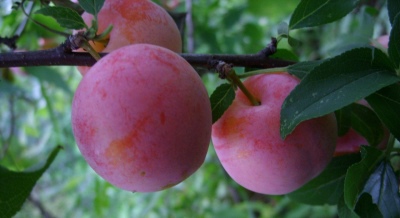
- Authors: M.N. Matyunin (Research Institute of Horticulture of Siberia named after M.A.Lisavenko)
- Year of approval: 2005
- Growth type: medium-sized
- Crown: paniculate, rare
- Fruit size: large
- Fruit weight, g: 34,6
- Fruit shape: oval, almost round
- Fruit color: main - yellow, integumentary - burgundy-red
- Skin : no bitterness
- Pulp (consistency): fibrous
Plum Xenia can be grown even by novice gardeners. However, fresh and relevant information about this culture is all the more important to them. It is necessary to study both consumer and botanical qualities, and the peculiarities of cultivation.
Description of the variety
This representative of stone fruit crops is included in the federal plant register in 2005. The developer is the Altai Scientific Center of Agrobiotechnology. The project was supervised by Nikolai Matyunin. The tree, universal in its purpose, grows rapidly. It is crowned with a sparse crown of a paniculate structure.
Thick shoots resemble arcs in shape. The surface of the shoots is brown-gray. The large foliage is similar in shape to an inverted egg. Its surface is light green, the edge is crenated. The culture belongs to the category of Chinese plums; medium-sized flowers are white.
Fruit characteristics
Ksenia's odnokostyanka are rounded. They are typically reddish in color; the average weight is about 34-35 grams. The pulp is colored yellowish-white. Subcutaneous points are colored in light colors, hardly noticeable. The abdominal suture is moderately pronounced, the pulp is fibrous.
Taste qualities
The official description indicates that it is a sweet and sour variety. Its pulp is distinguished by expressive juiciness. The average tasting score with professional expertise is 4.5 points out of five possible. The share of dry matter is 15.6%. The inclusion of 10.3% sugars is balanced by the presence of 1.2% acids (and among them there is also a very useful vitamin C).
Ripening and fruiting
You can feast on the first odnokostyanka already in the fourth year after planting. Of course, subject to competent agricultural technology and the right choice of site. In the future, fruiting goes on, albeit irregularly, for quite a long time. The exact time depends on the efforts made by the gardeners. It is believed to be an early (early maturing) variety.

Yield
Even on the website of the State Varietal Register, this characteristic is not indicated. In other sources, she also goes by with icy silence everywhere. An accurate assessment of productivity is hampered by the fact that crops are harvested haphazardly. For the same reason, it is definitely impossible to assess the influence of certain environmental factors on them.
Growing regions
Officially, the culture is zoned for the West Siberian region, which includes the Altai Territory, Kemerovo, Novosibirsk, Omsk, Tomsk, Tyumen regions, as well as the Altai Republic.However, that is why it is worth noting that it has every chance of showing itself well in areas with more favorable climatic conditions.
Self-fertility and the need for pollinators
Plum Xenia is not self-fertile. Therefore, next to it, it is imperative to plant other varieties as pollinators. The main thing is to choose those that bloom and ripen at the same time as the described culture.
Growing and care
The ridge for the Xenia plum should not be high - it is about 50 centimeters. The width reaches 200 cm. It is necessary to maintain a distance of at least 200 cm between the seedlings. It is inappropriate to use seedlings older than 2 years. When planting, the soil should be thoroughly trampled so that it is organically compacted. At the edge of the planting hole, a soil roller is equipped, which excludes arbitrary spreading of water during irrigation.
Protection against the moth is provided with Bordeaux liquid. Aphids are eliminated by using the drug "Oxyhom". The fight against beetles is carried out by liming the trunk. Watering intervals are 7 days. More frequent irrigation leads to rotting and other problems; pruning is carried out only before flowering.




Disease and pest resistance
Medium resistance to fungal infections. A high susceptibility to damping off can be a problem. Among insects, the danger is:
ants;
aphid;
moth.

Despite the fact that plum is considered more hardy than many fruit trees, it is not immune from diseases. It is attacked by viral, fungal and bacterial infections, and parasitic insects harm it. It is necessary to notice and recognize the signs of plum disease in time. They are easier to deal with and defeat early on. Well, in order to protect the garden tree from such a misfortune in the future, preventive procedures can be carried out.
Resistance to soil and climatic conditions
Plum Ksenia is declared as resistant to winter. The Chinese tree is evolutionarily adapted to damp winters with little snow, cool damp summers and relatively dry autumn months. The culture is hygrophilous. However, stagnant soil water, especially on cold soil, is poorly tolerated.



































































